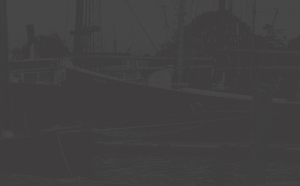About the Ship
Whaling Schooner/Brig, Kate Cory
Owner: Alexander Cory
Built: 1856 Allen and Sisson Shipyard, Westport Point, MA
Length on Deck: 75 feet Depth of Hold: 9 feet Beam; 22 feet
The whaler, Kate Cory was built in Westport, Massachusetts at the shipyard of Allen and Sisson. The Corys were a prominent family in Westport and whaling was just one interest of the family patriarch, Alexander. He commissioned Allen and Sisson (the shipyard located directly behind the Cory’s store) to build a schooner for the whaling trade and it was to be named for his six year old daughter, Kate.
A vessel of modest size and tonnage (seventy five feet, on deck and 132 tons), especially when compared to most whaling ships of 300 tons or more, Kate Cory was the last “large” ship to be built at the yard. Early in her short career, it was decided that she should be re-rigged as a brig. The theory being that the addition of square sails would make her a more stable craft from which to ply her trade. It must have worked, because that is how she spent the rest of her brief time afloat.
A word about her designation, “brig”: a brig is usually defined as a small vessel with two masts, having square sails on both. Kate Cory was rigged with square sails on the foremast only and a typical gaff rig on the mainmast. This would seem to make her a brigantine. I have seen different written accounts where she has been referred to as a brig, a hermaphrodite brig and a brigantine, leading me to believe that the terms were used somewhat interchangeably. British newspaper references were usually to the brigantine, Kate Cory. So, perhaps it was largely a British/American english language discrepancy.
The Cory had a number of successful and largely uneventful voyages . But on April 15, 1863, she ran afoul of the Confederate raider, Alabama off the coast of Brazil. She was taken as a prize, along with another Yankee whaler from New Bedford, the bark, Lafayette. The Lafayette was burned on the spot and her crew brought aboard the Alabama. But the Cory was towed to a nearby island where a third whaler, the Louisa Hatch was anchored. She had been taken as a prize earlier.
Captain Semmes, the commander of the Alabama, made the decision that the Louisa Hatch be burned and that the prisoners be transferred to the Kate Cory and then with a security detail on board, sail her to a convenient port in the Brazilian state of Pernambuco. There, the crews would be turned over to the local government with three weeks’ provisions from the plundered ships. After being pardoned, they would be released to find their own way back to North America.
On the morning of April 17, a Brazilian schooner came along side the Alabama and Captain Semmes engaged the schooner to take his prisoners (now numbering 140) to Pernambuco, thereby saving the Alabama the trouble of landing the prisoners safely.
With no further need of the Cory, it was decided that both whalers would be towed off shore and burned. At the time of her capture, the Kate Cory had 244 barrels of sperm oil aboard. It must have made quite a sight when the little ship burned to the waterline.
